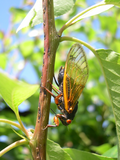 | Periodical cicadas (redirect from Magicicada) cicada is commonly used to refer to any of the seven species of the genus Magicicada of eastern North America, the 13- and 17-year cicadas. They are called... 109 KB (11,058 words) - 00:43, 17 April 2024 |
 | Magicicada tredecim is a 13-year species of periodical cicada, closely related to the newly discovered 13-year species Magicicada neotredecim, from which... 3 KB (323 words) - 02:22, 16 December 2021 |
 | Magicicada septendecim, sometimes called the Pharaoh cicada or the 17-year locust, is native to Canada and the United States and is the largest and most... 17 KB (1,850 words) - 16:36, 18 April 2024 |
 | Magicicada tredecassini is a species of periodical cicada endemic to the United States. It has a 13-year lifecycle but is otherwise indistinguishable from... 2 KB (206 words) - 18:04, 18 June 2023 |
Magicicada neotredecim is the most recently discovered species of periodical cicada. Like all Magicicada species, M. neotredecim has reddish eyes and wing... 8 KB (800 words) - 05:21, 9 September 2021 |
 | Magicicada septendecula is a species of insect in family Cicadidae. It is endemic to the United States. Their median lifespan from egg to natural adult... 2 KB (156 words) - 05:03, 14 April 2023 |
 | 2024. Brood XIII Magicicada in various stages of molting. Brood XIII instar Newly molted Brood XIII A group of Brood XIII Magicicada on a bush Brood XIII... 19 KB (1,903 words) - 11:02, 10 April 2024 |
Magicicada tredecula is a species of periodical cicada in the family Cicadidae. It is endemic to the United States. As its specific epithet implies, they... 2 KB (144 words) - 05:22, 9 September 2021 |
 | and die-off at long intervals (many years). Some periodical cicada (Magicicada) species erupt in large numbers from their larval stage at intervals in... 5 KB (543 words) - 19:13, 31 December 2023 |
 | calling for mates. Brood V consists of three species of 17-year cicadas: Magicicada septendecim, Magicicada cassini, and Magicicada septendecula. Brood V... 2 KB (174 words) - 23:50, 6 September 2023 |
 | closely related species of periodical cicadas: Magicicada septendecim, Magicicada tredecim, and Magicicada neotredecim. M. septendecim, first described... 8 KB (878 words) - 02:37, 19 October 2022 |
 | Brood II is one of 15 separate broods of Magicicada (periodical cicadas) that appear regularly throughout the northeastern United States. Every 17 years... 4 KB (485 words) - 18:43, 28 October 2023 |
 | first scientific paper on the North American 17-year periodical cicada, Magicicada septendecim. Kalm wrote an account of his travels that was translated... 13 KB (1,368 words) - 01:19, 19 April 2024 |
of the smallest 17-year broods, consisting exclusively of the species Magicicada septendecim, and was historically restricted to areas of Connecticut,... 5 KB (712 words) - 07:06, 21 January 2024 |
 | the intervening years. The most well-known periodical cicadas, genus Magicicada, emerge as adults every 13 or 17 years. Cicadas are known for the loud... 16 KB (1,452 words) - 01:28, 29 March 2024 |
 | measures. The evolutionary strategy used by cicadas of the genus Magicicada makes use of prime numbers. These insects spend most of their lives as... 116 KB (14,104 words) - 05:51, 23 April 2024 |
CGI short titled Red Ash: -Gearworld-, originally known as Red Ash: -Magicicada-, was funded by a separate Kickstarter campaign handled by Studio 4°C... 25 KB (1,989 words) - 22:32, 19 March 2024 |
 | Boulard, 1971 c g Lamotialna Boulard, 1976 c g Lemuriana Distant, 1905 g Magicicada Davis, 1925 i c g b (periodical cicadas) Monomatapa Distant, 1879 c g... 7 KB (540 words) - 05:33, 23 April 2024 |
 | hijacks the sexual signals of periodical cicadas (Hemiptera: Cicadidae: Magicicada)". Scientific Reports. 8 (1): 1432. Bibcode:2018NatSR...8.1432C. doi:10... 6 KB (617 words) - 02:38, 7 April 2024 |







